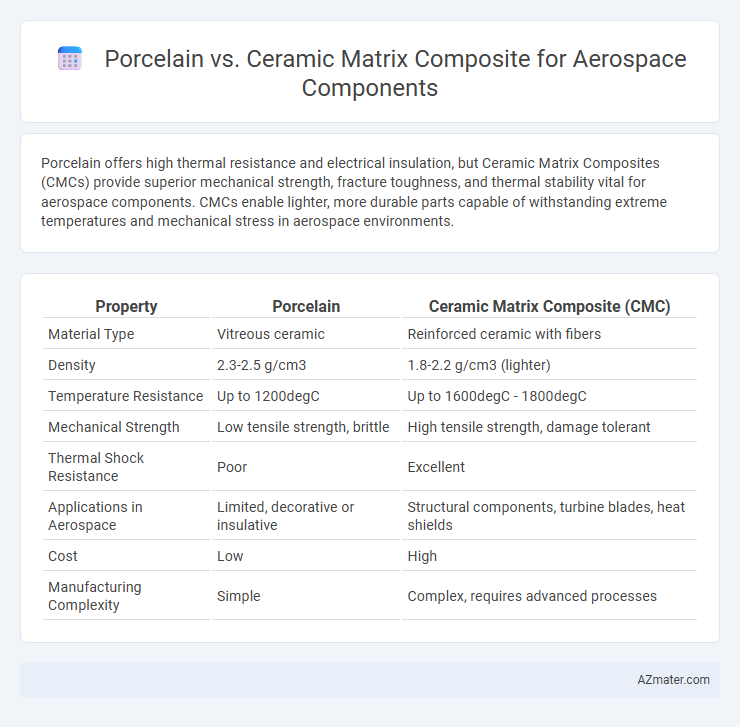Porcelain offers high thermal resistance and electrical insulation, but Ceramic Matrix Composites (CMCs) provide superior mechanical strength, fracture toughness, and thermal stability vital for aerospace components. CMCs enable lighter, more durable parts capable of withstanding extreme temperatures and mechanical stress in aerospace environments.
Table of Comparison
| Property | Porcelain | Ceramic Matrix Composite (CMC) |
|---|---|---|
| Material Type | Vitreous ceramic | Reinforced ceramic with fibers |
| Density | 2.3-2.5 g/cm3 | 1.8-2.2 g/cm3 (lighter) |
| Temperature Resistance | Up to 1200degC | Up to 1600degC - 1800degC |
| Mechanical Strength | Low tensile strength, brittle | High tensile strength, damage tolerant |
| Thermal Shock Resistance | Poor | Excellent |
| Applications in Aerospace | Limited, decorative or insulative | Structural components, turbine blades, heat shields |
| Cost | Low | High |
| Manufacturing Complexity | Simple | Complex, requires advanced processes |
Introduction to Aerospace Materials
Porcelain and ceramic matrix composites (CMCs) represent distinct material classes utilized in aerospace components due to their unique thermal and mechanical properties. Porcelain, a traditional ceramic, offers high hardness and thermal insulation but lacks the toughness required for high-stress aerospace environments. Ceramic matrix composites combine ceramic fibers with a ceramic matrix to provide enhanced fracture toughness, thermal stability, and damage tolerance crucial for aerospace applications such as turbine engine components and thermal protection systems.
Overview of Porcelain in Aerospace Applications
Porcelain in aerospace applications offers exceptional thermal insulation, high wear resistance, and excellent dielectric properties, making it ideal for insulating components and thermal barrier coatings. Its low thermal conductivity and resistance to thermal shock help protect sensitive aerospace parts from extreme temperature fluctuations during flight. The material's structural stability under high stress and corrosive environments ensures durability and reliability in critical aerospace components.
Ceramic Matrix Composites: Definition and Properties
Ceramic matrix composites (CMCs) are advanced materials composed of ceramic fibers embedded within a ceramic matrix, designed to enhance toughness and thermal resistance compared to traditional monolithic ceramics. CMCs exhibit superior high-temperature stability, low density, and excellent fracture toughness, making them ideal for aerospace components exposed to extreme thermal and mechanical stresses. Their enhanced durability and oxidation resistance contribute to improved performance and longevity in demanding aerospace applications such as turbine engines and thermal protection systems.
Mechanical Strength Comparison
Porcelain exhibits high compressive strength but limited tensile strength and fracture toughness, which restricts its application in aerospace components subjected to complex loading conditions. Ceramic matrix composites (CMCs) combine ceramic fibers with a ceramic matrix, resulting in significantly enhanced mechanical strength, including improved fracture toughness, tensile strength, and resistance to thermal shock. The superior mechanical performance of CMCs makes them ideal for aerospace components that require durability under extreme mechanical stresses and high-temperature environments.
Thermal Resistance and Stability
Porcelain offers superior thermal resistance withstanding temperatures up to 1,200degC, making it suitable for components exposed to moderate heat but lacks the toughness required for aerospace durability. Ceramic Matrix Composites (CMCs) demonstrate exceptional thermal stability and resistance beyond 1,500degC, combined with high fracture toughness and mechanical strength essential for aerospace applications. The enhanced thermal shock resistance and oxidation protection of CMCs improve reliability and lifespan in harsh aerospace environments compared to traditional porcelain materials.
Weight and Density Differences
Porcelain typically exhibits higher density and weight compared to ceramic matrix composites (CMCs), which are engineered for lightweight aerospace applications. Ceramic matrix composites combine ceramic fibers with a ceramic matrix, significantly reducing density to approximately 2.5-3.5 g/cm3 versus porcelain's density of around 2.8-3.0 g/cm3. This weight advantage enables CMCs to improve fuel efficiency and payload capacity in aerospace components while maintaining high-strength and thermal resistance.
Durability and Fatigue Life
Porcelain exhibits limited durability and fatigue life under aerospace conditions due to its brittleness and susceptibility to crack propagation, whereas Ceramic Matrix Composites (CMCs) offer significantly enhanced toughness and resistance to thermal shock. CMCs maintain structural integrity under cyclic loading by combining ceramic fibers with a ceramic matrix, resulting in improved fracture toughness and longer fatigue life, critical for aerospace components exposed to extreme stress. These properties make CMCs more reliable for high-temperature and high-stress aerospace applications compared to conventional porcelain materials.
Manufacturing Processes and Cost Analysis
Porcelain manufacturing involves traditional kiln firing of clay and minerals, offering lower material costs but limited high-temperature performance compared to Ceramic Matrix Composites (CMCs), which require advanced processes like chemical vapor infiltration or slurry infiltration that increase production complexity and expense. CMC production benefits aerospace components through superior thermal resistance and mechanical strength, justifying higher initial costs with enhanced durability and reduced maintenance. Cost analysis reveals porcelain is economically viable for non-critical parts, whereas CMCs deliver long-term value in high-stress environments despite significant upfront investment in fabrication technology.
Application Suitability in Aerospace Components
Porcelain exhibits high hardness and wear resistance but remains brittle under extreme thermal stress, limiting its suitability for aerospace components exposed to rapid temperature fluctuations. Ceramic matrix composites (CMCs), combining ceramic fibers with a ceramic matrix, offer superior thermal shock resistance, fracture toughness, and reduced weight, making them ideal for turbine blades, heat shields, and structural parts in aerospace applications. The enhanced mechanical properties and thermal stability of CMCs directly address the demanding operational conditions within aerospace environments, outperforming traditional porcelain materials.
Future Trends in Aerospace Material Selection
Porcelain and ceramic matrix composites (CMCs) differ significantly in aerospace applications, with CMCs offering superior thermal resistance, fracture toughness, and weight savings crucial for future aerospace component design. Emerging trends prioritize CMCs for engine components and thermal protection systems due to their ability to withstand extreme temperatures and reduce overall aircraft weight, directly impacting fuel efficiency and emissions. Advances in nanoscale reinforcement and hybrid composites are expected to further enhance CMC performance, positioning them as the material of choice over traditional porcelain for next-generation aerospace materials.

Infographic: Porcelain vs Ceramic Matrix Composite for Aerospace Component
 azmater.com
azmater.com